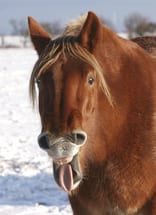Equine Allergies
 Horses, like other animals, can have environmental allergies or allergic reactions to feed, insect bites or medications. During allergic reactions, the body's immune system overreacts to otherwise harmless substances as if they were pathogens. These allergens can cause reactions ranging from mild to severe, and may include skin disturbances, respiratory problems, and even life-threatening anaphylaxis.
Horses, like other animals, can have environmental allergies or allergic reactions to feed, insect bites or medications. During allergic reactions, the body's immune system overreacts to otherwise harmless substances as if they were pathogens. These allergens can cause reactions ranging from mild to severe, and may include skin disturbances, respiratory problems, and even life-threatening anaphylaxis.
Causes of Equine Allergies
Horse can allergic to airborne particles, materials that come into contact with their skin, and medications.
Environmental Causes
Environmental allergens that may affect horses include dust, pollen and mold. For many animals, allergies may be seasonal. Materials the horse comes into contact with can also result in allergic reactions. Rarely, a horse may be allergic to its feed. Most commonly, contact allergens are dusty or moldy hay or bedding. Sometimes horses react adversely to fly sprays or other pesticides.
Insect Bites
Insect bites are a frequent source of localized allergic reactions in horses. A particular small gnat (Culicoides) is often the culprit. The irritation this insect causes is colloquially referred to as "sweet itch."
Vaccinations and Medications
Although vaccinations are tested carefully and are safe for the vast majority of animals, an occasional individual horse may be troubled by a particular shot. A veterinarian should always be consulted when a horse has an allergic reaction to a vaccination because the reaction to the next shot may be worse. Sometimes this problem can be helped by giving vaccinations individually rather than as a combination injection.
Horses can also be allergic to other medications whether administered topically, orally or by injection.
Symptoms of Equine Allergies
Equine allergies manifest in three primary ways.
Skin Reactions
The mildest equine allergic reactions, which fortunately are also the most common, are skin irritations, involving redness, swelling and itching. These may be seasonal in reaction to pollen and mold spores or may result from vaccinations or insect bites.
Hives that cover much more of the body represent a more dangerous reaction since they may appear internally as well as externally, interfering with respiration.
Respiratory Reactions
Respiratory allergies are also common and may be the result of the same pollens or molds that cause skin irritations. They are more frequently found in horses that inhabit a dusty environment. A relatively common manifestation of respiratory allergies in horses is Recurrent Airway Obstruction (RAO), known as heaves which is similar to asthma in humans.
Anaphylactic Shock
Anaphylactic shock is a severe, life-threatening allergic reaction. Though rare, anaphylaxis can occur after the administration of any drug or vaccine and is sometimes observed in horses that have been given transfusions. When foals must receive plasma, they should be watched carefully for signs of anaphylaxis.
Symptoms of Anaphylaxis include:
- Severe hives
- Pale or flushed skin
- Increased respiration
- Low blood pressure
- Difficulty breathing
- Weak, rapid pulse
- Vomiting or diarrhea
- Collapse
Urgent care is required to save a horse from anaphylactic shock. The reaction occurs suddenly and is immediately severe. Epinephrine must be administered immediately to save the animal's life
Diagnosis of Equine Allergies
 Sometimes the cause of an allergic reaction is self-evident, as when it occurs immediately after an injection or insect bite or when the horse has recently changed feed or been in contact with new bedding or a new shampoo. At other times, the diagnosis of equine allergies involves a certain amount of detective work.
Sometimes the cause of an allergic reaction is self-evident, as when it occurs immediately after an injection or insect bite or when the horse has recently changed feed or been in contact with new bedding or a new shampoo. At other times, the diagnosis of equine allergies involves a certain amount of detective work.
Factors that help the veterinarian figure out the allergen involved include: the location of the reaction site, the season of the year, any changes in feed, bedding or general environment, and a recent history of the horse's activities.
Tests that may be performed to assist in diagnosis include:
- Skin tests on a shaved area
- Intradermal skin tests
- Biopsies
- Blood tests
A complicating factor in diagnosing equine allergies is that other medical problems can sometimes be mistaken for allergic reactions. These include sunburn, photosensitization from plants, and lungworms.
Treatment of Equine Allergies
The simplest and most effective treatment for allergies is to remove the affecting allergen, though of course this is not always possible. When it is practical, the horse can be kept in a screened area during dawn and dusk when insects are most likely to bite. It is also possible to change feed, supplements, grooming products, or insect sprays.
Other treatments for equine allergies include antihistamines and corticosteroids. In some cases, allergy injections may be administered.
